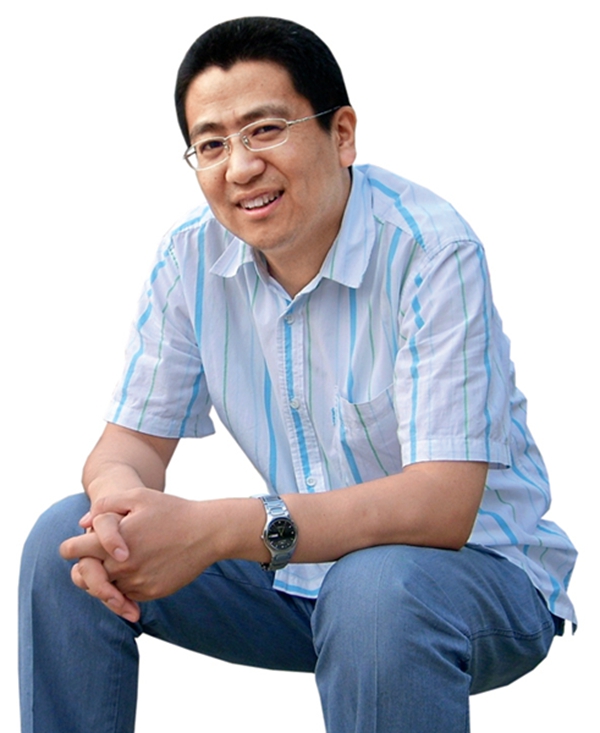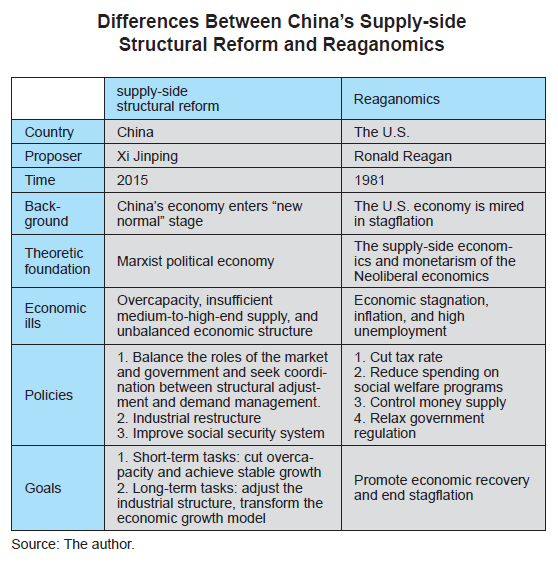By LI GANG
By LI GANG
THE Chinese government first raised the idea of supply-side structural reform in November 2015. A month later it specified the five aims of this reform. They are: reducing overcapacity; cutting excess inventory; deleveraging; lowering costs; and shoring up weak areas in economic growth, so as to address overcapacity, insufficient medium- to-high-end supply, and an unbalanced economic structure. This concept differs from Ronald Reagan’s supply-side strategy regarding background, theoretical foundation, economic policy, and goals.
Different Background, Different Economic Problems
In the 1970s, the oil crisis and resultant soaring oil prices severely affected the economies of the world’s major industrialized countries. Developed economies such as the U.K. and the U.S. became mired in economic recession, rising prices, and high unemployment.

Li Gang is a research fellow at the Institute of European Studies in the Chinese Academy of Social Sciences.
From 2010 to 2011, he did research as a visiting scholar at the Department of Public Administration at Erasmus
University, Rotterdam. In his research, he focuses on European economy and the foreign relations between China and
European countries. He has published in various Chinese and English journals and books.
The impact of the first “oil shock” of 1973 plunged the U.S. into economic stagnation, having registered a negative GDP growth of 0.5 percent in 1974 that fell to 0.2 percent in 1975. To tackle the recession, the Federal Reserve (FED) adopted a loose monetary policy in efforts to stimulate economic growth, and which brought about a surging broad measure of money supply (M2).
Yet the policy failed to stimulate investment and growth. It caused serious inflation, evident in a rise in this respect from 6.2 percent in 1973 to 11 percent in 1974. After the second oil shock of 1979, the U.S. economy slid once more into recession and inflation continued to climb. In 1980, the GDP growth rate fell to -0.2 percent and inflation hit 13.5 percent.
Under the background of failed demand management policies, the Reagan administration adopted the neoliberal policies associated with supply-side economics. Aimed at promoting investment and economic recovery, they included cutting taxes, reducing government spending, and relaxing government regulation of businesses. The so-called Reaganomics approach was proposed after the U.S. economy had slipped into stagflation to tackle economic stagnation, inflation, and high unemployment.
Chinese President Xi Jinping formally proposed supply-side structural reform at the 11th meeting of the Central Leading Group for Financial and Economic Affairs in November 2015. The reform was raised under the macro-economic background of China’s economy entering the “new normal” of medium-to-low growth.

In 2012, Chinese economic growth stood at 7.7 percent, the first time since 2000 it had been less than 8 percent. By 2015 growth had slowed to 6.9 percent, but was nevertheless higher than the average 4 percent of developing countries and 3.1 of the world as a whole. As to inflation, in 2015 the consumer price index (CPI) showed a year-on-year increase of 1.4 percent, a record low compared to the previous six years. Yet despite this slowdown, the country’s job market remains stable. Last year China created 13.12 million new jobs for urban residents, and at the end of 2015, registered unemployment in cities was 4.05 percent, according to Ministry of Human Resources and Social Security statistics.
Therefore, China’s supply-side structural reform was proposed at a time when the economy maintained medium-to-low growth and stable commodity prices, and featured higher employment – an entirely different background from that of the U.S. economy in the 1980s. Moreover, China’s supply-side structural reform targets the economic ills of oversupply of low-end goods and insufficient supply of high quality products, the waning role of investment in stimulating economic growth, overcapacity, and structural imbalances.
Different Theoretical Foundations
Reaganomics is mainly based on neoliberal supply-side economics and monetarism theories. Neoliberalism, which appeared in the 1920s and 1930s, is associated with the laissez-faire economic theory developed by Adam Smith at the end of the 18th century. It holds that the market mechanism automatically achieves balance, thus avoiding overproduction and obviating the need for government intervention.
The two oil crises in the 1970s left industrialized countries perplexed by high inflation and glacial growth. Keynesian economics, whose central tenet is that government intervention through fiscal and monetary policies can stabilize the economy, proved a failure.
It was under this background that Neoliberalism, neglected for many years, began to revive. Monetarists believe that excessive expansion of the money supply inevitably leads to inflation, while advocates of supply-side economics hold that lower taxation and less government regulation stimulate supply.
After taking office in 1981, Ronald Reagan cut taxes, reduced spending on social welfare programs, adjusted the money supply, and relaxed government regulation to stimulate the economy and reduce inflation. Therefore, Reagan implemented policies based on the economic theories of monetarism and supply-side economics.
In China, supply-side structural reform constitutes the country’s continuing and deepening efforts to establish a socialist market economy. It targets the various problems China faces as the Chinese economy enters a new stage of development.
That Chinese consumers are willing and eager to buy foreign products shows that it is not insufficient demand that impedes China’s economy but insufficient supply of quality, high-end products. In other words, the current supply does not fit the country’s changing consumption habits.
The core of supply-side structural reform, therefore, lies in adjusting the industrial structure, eliminating outdated industrial capacity, and dealing with overcapacity, so to reduce ineffective, low-end supply and increase effective, high-end supply.
The supply structure may then better adapt to the changing market demand as high quality products meet the needs of today’s more sophisticated consumers. Supply-side structural reform is hence based on Marxist political economy, whose fundamental theories, such as that the relations of production must conform to the level of the productive forces, and the labor theory of value, have been developed and applied to China’s economic reforms.
Different Economic Policies
When Reagan took office in 1981, he implemented an economic reform plan that set out to cut taxes, reduce spending on social welfare, control the money supply, and relax government control and regulation.
China’s supply-side structural reform consists not only in such specific measures as replacing business tax with value-added tax, improving the social security system, streamlining administration, and delegating more power to lower-level governments. It also entails long-term and strategic measures, such as adjusting the industrial structure, transforming the economic growth model, and expanding total factor productivity (TFP).
Compared with Reaganomics, the application of supply-side structural reform policies also has distinctive characteristics. First, supply-side reform balances the roles of market and government and promotes coordination between structural adjustment and demand management. It also emphasizes the fundamental role of the market in allocating resources as well as that of the government in helping to adjust the economy.
Second, supply-side structural reform aims to raise the quality of supply by adjusting and upgrading the industrial structure. The goals it sets for industrial development include: promoting agricultural modernization and integrative development of the primary, secondary, and tertiary industries in rural regions; accelerating the reform of cutting overcapacity and excess inventory, lowering costs, and eliminating outdated capacity; developing emerging and strategic industries; implementing the Made in China 2025 strategy; and facilitating development of the tertiary industry, because it is labor-intensive and non-polluting, and its development is conducive to creating new jobs and promoting development of the primary and secondary industries. A service-driven economic growth model is more inclusive and sustainable.
Third, supply-side structural reform stresses the concept of “sharing,” which means it strives to ensure society as a whole shares in the fruits of development. It therefore advocates enhancing the social security system and social welfare, and improving people’s livelihood.
Different Goals
As supply-side reform and Reaganomics were proposed under different backgrounds, to deal with different problems, they have different goals. Reaganomics aimed to promote rapid economic recovery. Supply-side structural reform has the multiple goals of emancipating and developing productive forces, increasing quality and efficient supply and reducing low-end ineffective supply, expanding TFP, and making supply better adapt to changing consumer demands and tastes.
Therefore, supply-side reform has both short-term and long-term aims. The aim of the former is cutting overcapacity and excess inventory, deleveraging, reducing costs, and strengthening points of weakness, so to achieve a stable growth.
Long-term goals are aimed at transforming the economic growth model to one driven by domestic consumption, rather than investment and foreign trade. It may thus realize the innovative, coordinated, green, open, and shared development, the five development concepts set out in China’s 13th Five-Year Plan.